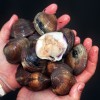
This 9-page fact sheet written by Huiping Yang, Natalie Simon, and Leslie Sturmer and published by the Program in Fisheries and Aquatic Sciences of the UF/IFAS School of Forest Resources and Conservation focused on basic aspects of triploid oyster aquaculture, including the general oyster aquaculture industry, the approaches for triploid induction, performance of triploids, and correlated ploidy determination to convey basic knowledge of triploid oyster aquaculture to the oyster industry and the general public.
http://edis.ifas.ufl.edu/fa208
Tag: Leslie Sturmer
Tracking the Economic Benefits Generated by the Hard Clam Aquaculture Industry in Florida
 The hard clam industry is a true success story for commercial aquaculture in Florida. From a cottage industry borne of reductions in commercial wild clam harvests in the Indian River Lagoon during the late 1980s, hard clam aquaculture has now developed into an industry that is rivaled by no other aquaculture food product in Florida. Although successful by virtually any metric, the risks and uncertainty associated with commercial hard clam culture has led to the evaluation of programs that help mitigate risk, such as the former pilot Cultivated Clam Crop Insurance Program administered by USDA Risk Management Agency. All of this alludes to the economic importance of the hard clam culture industry which, through the cultivation process and sales of products, generates local income and taxes, creates jobs and businesses, and draws new money into the local economy, as cultured hard clams are sold to non-residents and buyers outside the region and state. This 6-page fact sheet provides an overview of a recent study by the University of Florida to provide an estimate of the impact of the hard clam industry to the Florida economy. Written by Charles Adams, Leslie Sturmer, and Alan Hodges, and published by the UF Department of Food and Resource Economics, October 2014. (UF/IFAS photo by Tom Wright)
The hard clam industry is a true success story for commercial aquaculture in Florida. From a cottage industry borne of reductions in commercial wild clam harvests in the Indian River Lagoon during the late 1980s, hard clam aquaculture has now developed into an industry that is rivaled by no other aquaculture food product in Florida. Although successful by virtually any metric, the risks and uncertainty associated with commercial hard clam culture has led to the evaluation of programs that help mitigate risk, such as the former pilot Cultivated Clam Crop Insurance Program administered by USDA Risk Management Agency. All of this alludes to the economic importance of the hard clam culture industry which, through the cultivation process and sales of products, generates local income and taxes, creates jobs and businesses, and draws new money into the local economy, as cultured hard clams are sold to non-residents and buyers outside the region and state. This 6-page fact sheet provides an overview of a recent study by the University of Florida to provide an estimate of the impact of the hard clam industry to the Florida economy. Written by Charles Adams, Leslie Sturmer, and Alan Hodges, and published by the UF Department of Food and Resource Economics, October 2014. (UF/IFAS photo by Tom Wright)
http://edis.ifas.ufl.edu/fe961
FA152 The Role of Dissolved Oxygen in Hard Clam Aquaculture
FA152, an 11-page illustrated fact sheet by Kerry Weber, Elise Hoover, Leslie Sturmer, and Shirley Baker, discusses dissolved oxygen in clam leases, how to monitor varying concentrations, signs of oxygen stress, how it affects hard clam production, and how to develop a management strategy to adapt to dissolved oxygen levels. Includes contact information for state specialists, glossary and references. Published by the UF Program of Fisheries and Aquatic Sciences of the School of Forest Resources and Conservation, December 2008.
http://edis.ifas.ufl.edu/FA152